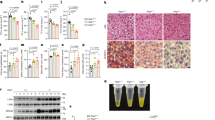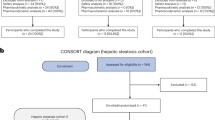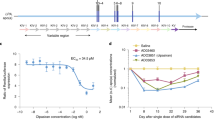Key Points
-
Angiopoietin-like 3 (ANGPTL3) is a liver-derived circulating factor that inhibits the enzyme lipoprotein lipase
-
ANGPTL3 works in tandem with its close relative ANGPTL8
-
Loss-of-function mutations in ANGPTL3 are associated with reductions in plasma levels of low-density lipoprotein (LDL) cholesterol, high-density lipoprotein cholesterol and triglycerides in humans
-
Antisense oligonucleotide- and antibody-based targeting of ANGPTL3 lowers plasma triglycerides and LDL cholesterol in humans
Abstract
Triglycerides and cholesterol circulate in the bloodstream as part of various lipoprotein particles. Three members of the angiopoietin-like (ANGPTL) protein family — ANGPTL3, ANGPTL4 and ANGPTL8 — have emerged as important regulators of plasma lipoprotein levels by inhibiting the enzyme lipoprotein lipase. Here, I review the role of ANGPTL3 in lipoprotein metabolism. In contrast to ANGPTL4 and ANGPTL8, ANGPTL3 is exclusively produced in the liver and can therefore be classified as a true hepatokine. ANGPTL3 cooperates with ANGPTL8 to inhibit lipoprotein lipase and is mostly active after feeding, whereas ANGPTL4 is mostly active after fasting. Inactivation of ANGPTL3 in mice reduces plasma triglyceride and free fatty acid levels and suppresses atherosclerosis. In humans, homozygous loss-of-function mutations in ANGPTL3 lead to low plasma levels of low-density lipoproteins, high-density lipoproteins and triglycerides, a condition referred to as familial combined hypolipidaemia. Heterozygous carriers of loss-of-function mutations in ANGPTL3 have a lower risk of coronary artery disease than non-carriers. At present, researchers are investigating antisense oligonucleotide and monoclonal antibody-based inactivation of ANGPTL3 in human clinical trials for the therapeutic management of dyslipidaemia and atherosclerosis. Thus, ANGPTL3 is an important liver-derived regulator of lipoprotein metabolism that holds considerable promise as a target for atherosclerosis.
This is a preview of subscription content, access via your institution
Access options
Access Nature and 54 other Nature Portfolio journals
Get Nature+, our best-value online-access subscription
$29.99 / 30 days
cancel any time
Subscribe to this journal
Receive 12 print issues and online access
$209.00 per year
only $17.42 per issue
Buy this article
- Purchase on Springer Link
- Instant access to full article PDF
Prices may be subject to local taxes which are calculated during checkout



Similar content being viewed by others
References
Bonanni, L., Cutolo, A. & Dalla Vestra, M. Novel approaches for the treatment of familial hypercholesterolemia. Exp. Clin. Endocrinol. Diabetes 124, 583–587 (2016).
Banach, M. et al. Statin intolerance — an attempt at a unified definition. Position paper from an international lipid expert panel. Expert Opin. Drug Saf. 14, 935–955 (2015).
Orringer, C. E. et al. Update on the use of PCSK9 inhibitors in adults: recommendations from an expert panel of the National Lipid Association. J. Clin. Lipidol. 4, 880–890 (2017).
Mattijssen, F. & Kersten, S. Regulation of triglyceride metabolism by angiopoietin-like proteins. Biochim. Biophys. Acta 1821, 782–789 (2012).
Conklin, D. et al. Identification of a mammalian angiopoietin-related protein expressed specifically in liver. Genomics 62, 477–482 (1999).
Kersten, S. Physiological regulation of lipoprotein lipase. Biochim. Biophys. Acta 1841, 919–933 (2014).
Shimamura, M. et al. Angiopoietin-like protein3 regulates plasma HDL cholesterol through suppression of endothelial lipase. Arterioscler. Thromb. Vasc. Biol. 27, 366–372 (2007).
Musunuru, K. et al. Exome sequencing, ANGPTL3 mutations, and familial combined hypolipidemia. N. Engl. J. Med. 363, 2220–2227 (2010).
Zandbergen, F., van Dijk, S., Muller, M. & Kersten, S. Fasting-induced adipose factor/angiopoietin-like protein 4: a potential target for dyslipidemia. Future Lipidol. 1, 227–236 (2006).
Catoire, M. et al. Fatty acid-inducible ANGPTL4 governs lipid metabolic response to exercise. Proc. Natl. Acad. Sci. USA 111, E1043–E1052 (2014).
Dijk, W. et al. ANGPTL4 mediates shuttling of lipid fuel to brown adipose tissue during sustained cold exposure. eLife 4, e08428 (2015).
Kersten, S. et al. Characterization of the fasting-induced adipose factor FIAF, a novel peroxisome proliferator-activated receptor target gene. J. Biol. Chem. 275, 28488–28493 (2000).
Kroupa, O. et al. Linking nutritional regulation of Angptl4, Gpihbp1, and Lmf1 to lipoprotein lipase activity in rodent adipose tissue. BMC Physiol. 12, 13 (2012).
Sukonina, V., Lookene, A., Olivecrona, T. & Olivecrona, G. Angiopoietin-like protein 4 converts lipoprotein lipase to inactive monomers and modulates lipase activity in adipose tissue. Proc. Natl Acad. Sci. USA 103, 17450–17455 (2006).
Desai, U. et al. Lipid-lowering effects of anti-angiopoietin-like 4 antibody recapitulate the lipid phenotype found in angiopoietin-like 4 knockout mice. Proc. Natl Acad. Sci. USA 104, 11766–11771 (2007).
Lichtenstein, L. et al. Angptl4 protects against severe proinflammatory effects of saturated fat by inhibiting fatty acid uptake into mesenteric lymph node macrophages. Cell Metab. 12, 580–592 (2010).
Quagliarini, F. et al. Atypical angiopoietin-like protein that regulates ANGPTL3. Proc. Natl Acad. Sci. USA 109, 19751–19756 (2012).
Ren, G., Kim, J. Y. & Smas, C. M. Identification of RIFL, a novel adipocyte-enriched insulin target gene with a role in lipid metabolism. Am. J. Physiol. Endocrinol. Metab. 303, E334–E351 (2012).
Zhang, R. Lipasin, a novel nutritionally-regulated liver-enriched factor that regulates serum triglyceride levels. Biochem. Biophys. Res. Commun. 424, 786–792 (2012).
Cox, A. R. et al. Angiopoietin-like protein 8 (ANGPTL8)/betatrophin overexpression does not increase beta cell proliferation in mice. Diabetologia 58, 1523–1531 (2015).
Gusarova, V. et al. ANGPTL8/betatrophin does not control pancreatic beta cell expansion. Cell 159, 691–696 (2014).
Jiao, Y., Le Lay, J., Yu, M., Naji, A. & Kaestner, K. H. Elevated mouse hepatic betatrophin expression does not increase human beta-cell replication in the transplant setting. Diabetes 63, 1283–1288 (2014).
Yi, P., Park, J. S. & Melton, D. A. Betatrophin: a hormone that controls pancreatic β cell proliferation. Cell 153, 747–758 (2013).
Yi, P., Park, J. S. & Melton, D. A. Retraction notice to: Betatrophin: a hormone that controls pancreatic β cell proliferation. Cell 168, 326 (2017).
Dewey, F. E. et al. Genetic and pharmacologic inactivation of ANGPTL3 and cardiovascular disease. N. Engl. J. Med. 377, 211–221 (2017).
Graham, M. J. et al. Cardiovascular and metabolic effects of ANGPTL3 antisense oligonucleotides. N. Engl. J. Med. 377, 222–232 (2017).
Koishi, R. et al. Angptl3 regulates lipid metabolism in mice. Nat. Genet. 30, 151–157 (2002).
Fu, Z., Yao, F., Abou-Samra, A. B. & Zhang, R. Lipasin, thermoregulated in brown fat, is a novel but atypical member of the angiopoietin-like protein family. Biochem. Biophys. Res. Commun. 430, 1126–1131 (2013).
Jin, W. et al. Hepatic proprotein convertases modulate HDL metabolism. Cell Metab. 6, 129–136 (2007).
Ono, M. et al. Protein region important for regulation of lipid metabolism in angiopoietin-like 3 (ANGPTL3): ANGPTL3 is cleaved and activated in vivo. J. Biol. Chem. 278, 41804–41809 (2003).
Essalmani, R. et al. Furin is the primary in vivo convertase of angiopoietin-like 3 and endothelial lipase in hepatocytes. J. Biol. Chem. 288, 26410–26418 (2013).
Khetarpal, S. A. et al. Loss of function of GALNT2 lowers high-density lipoproteins in humans, nonhuman primates, and rodents. Cell Metab. 24, 234–245 (2016).
Schjoldager, K. T. et al. O-Glycosylation modulates proprotein convertase activation of angiopoietin-like protein 3: possible role of polypeptide GalNAc-transferase-2 in regulation of concentrations of plasma lipids. J. Biol. Chem. 285, 36293–36303 (2010).
Romeo, S. et al. Rare loss-of-function mutations in ANGPTL family members contribute to plasma triglyceride levels in humans. J. Clin. Invest. 119, 70–79 (2009).
Liu, J. et al. A novel role of angiopoietin-like-3 associated with podocyte injury. Pediatr. Res. 77, 732–739 (2015).
Kaplan, R. et al. Regulation of the angiopoietin-like protein 3 gene by LXR. J. Lipid Res. 44, 136–143 (2003).
Ge, H. et al. Differential regulation and properties of angiopoietin-like proteins 3 and 4. J. Lipid Res. 46, 1484–1490 (2005).
Inaba, T. et al. Angiopoietin-like protein 3 mediates hypertriglyceridemia induced by the liver X receptor. J. Biol. Chem. 278, 21344–21351 (2003).
Fugier, C. et al. The lipoprotein lipase inhibitor ANGPTL3 is negatively regulated by thyroid hormone. J. Biol. Chem. 281, 11553–11559 (2006).
Inukai, K. et al. ANGPTL3 is increased in both insulin-deficient and -resistant diabetic states. Biochem. Biophys. Res. Commun. 317, 1075–1079 (2004).
Lu, B., Moser, A., Shigenaga, J. K., Grunfeld, C. & Feingold, K. R. The acute phase response stimulates the expression of angiopoietin like protein 4. Biochem. Biophys. Res. Commun. 391, 1737–1741 (2010).
Matsusue, K., Miyoshi, A., Yamano, S. & Gonzalez, F. J. Ligand-activated PPARβ efficiently represses the induction of LXR-dependent promoter activity through competition with RXR. Mol. Cell. Endocrinol. 256, 23–33 (2006).
Shimamura, M. et al. Angiopoietin-like protein 3, a hepatic secretory factor, activates lipolysis in adipocytes. Biochem. Biophys. Res. Commun. 301, 604–609 (2003).
Pramfalk, C., Parini, P., Gustafsson, U., Sahlin, S. & Eriksson, M. Effects of high-dose statin on the human hepatic expression of genes involved in carbohydrate and triglyceride metabolism. J. Intern. Med. 269, 333–339 (2011).
Tikka, A. et al. Silencing of ANGPTL 3 (angiopoietin-like protein 3) in human hepatocytes results in decreased expression of gluconeogenic genes and reduced triacylglycerol-rich VLDL secretion upon insulin stimulation. Biosci. Rep. 34, e00160 (2014).
Nidhina Haridas, P. A. et al. Regulation of angiopoietin-like proteins (ANGPTLs) 3 and 8 by insulin. J. Clin. Endocrinol. Metab. 100, E1299–E1307 (2015).
Ando, Y. et al. A decreased expression of angiopoietin-like 3 is protective against atherosclerosis in apoE-deficient mice. J. Lipid Res. 44, 1216–1223 (2003).
Fujimoto, K., Koishi, R., Shimizugawa, T. & Ando, Y. Angptl3-null mice show low plasma lipid concentrations by enhanced lipoprotein lipase activity. Exp. Anim. 55, 27–34 (2006).
Koster, A. et al. Transgenic angiopoietin-like (angptl)4 overexpression and targeted disruption of angptl4 and angptl3: regulation of triglyceride metabolism. Endocrinology 146, 4943–4950 (2005).
Wang, Y. et al. Hepatic ANGPTL3 regulates adipose tissue energy homeostasis. Proc. Natl Acad. Sci. USA 112, 11630–11635 (2015).
Gusarova, V. et al. ANGPTL3 blockade with a human monoclonal antibody reduces plasma lipids in dyslipidemic mice and monkeys. J. Lipid Res. 56, 1308–1317 (2015).
Wang, Y. et al. Inactivation of ANGPTL3 reduces hepatic VLDL-triglyceride secretion. J. Lipid Res. 56, 1296–1307 (2015).
Shimizugawa, T. et al. ANGPTL3 decreases very low density lipoprotein triglyceride clearance by inhibition of lipoprotein lipase. J. Biol. Chem. 277, 33742–33748 (2002).
Lee, E.-C. et al. Identification of a new functional domain in angiopoietin-like 3 (ANGPTL3) and angiopoietin-like 4 (ANGPTL4) involved in binding and inhibition of lipoprotein lipase (LPL). J. Biol. Chem. 284, 13735–13745 (2009).
Shan, L. et al. The angiopoietin-like proteins ANGPTL3 and ANGPTL4 inhibit lipoprotein lipase activity through distinct mechanisms. J. Biol. Chem. 284, 1419–1424 (2009).
Sonnenburg, W. K. et al. GPIHBP1 stabilizes lipoprotein lipase and prevents its inhibition by angiopoietin-like 3 and angiopoietin-like 4. J. Lipid Res. 50, 2421–2429 (2009).
Yau, M. H. et al. A highly conserved motif within the NH2-terminal coiled-coil domain of angiopoietin-like protein 4 confers its inhibitory effects on lipoprotein lipase by disrupting the enzyme dimerization. J. Biol. Chem. 284, 11942–11952 (2009).
Chi, X. et al. ANGPTL8 promotes the ability of ANGPTL3 to bind and inhibit lipoprotein lipase. Mol. Metab. http://dx.doi.org/10.1016/j.molmet.2017.06.014 (2017).
Haller, J. F. et al. ANGPTL8 requires ANGPTL3 to inhibit lipoprotein lipase and plasma triglyceride clearance. J. Lipid Res. 58, 1166–1173 (2017).
Mysling, S. et al. The angiopoietin-like protein ANGPTL4 catalyzes unfolding of the hydrolase domain in lipoprotein lipase and the endothelial membrane protein GPIHBP1 counteracts this unfolding. eLife 5, e20958 (2016).
Dijk, W. et al. Angiopoietin-like 4 promotes intracellular degradation of lipoprotein lipase in adipocytes. J. Lipid Res. 57, 1670–1683 (2016).
Liu, J., Afroza, H., Rader, D. J. & Jin, W. Angiopoietin-like protein 3 inhibits lipoprotein lipase activity through enhancing its cleavage by proprotein convertases. J. Biol. Chem. 285, 27561–27570 (2010).
Wang, Y. et al. Mice lacking ANGPTL8 (Betatrophin) manifest disrupted triglyceride metabolism without impaired glucose homeostasis. Proc. Natl Acad. Sci. USA 110, 16109–16114 (2013).
Kathiresan, S. et al. Six new loci associated with blood low-density lipoprotein cholesterol, high-density lipoprotein cholesterol or triglycerides in humans. Nat. Genet. 40, 189–197 (2008).
Teslovich, T. M. et al. Biological, clinical and population relevance of 95 loci for blood lipids. Nature 466, 707–713 (2010).
Willer, C. J. et al. Newly identified loci that influence lipid concentrations and risk of coronary artery disease. Nat. Genet. 40, 161–169 (2008).
Minicocci, I. et al. Effects of angiopoietin-like protein 3 deficiency on postprandial lipid and lipoprotein metabolism. J. Lipid Res. 57, 1097–1107 (2016).
Martin-Campos, J. M. et al. Identification of a novel mutation in the ANGPTL3 gene in two families diagnosed of familial hypobetalipoproteinemia without APOB mutation. Clin. Chim. Acta 413, 552–555 (2012).
Noto, D. et al. Prevalence of ANGPTL3 and APOB gene mutations in subjects with combined hypolipidemia. Arterioscler. Thromb. Vasc. Biol. 32, 805–809 (2012).
Pisciotta, L. et al. Characterization of three kindreds with familial combined hypolipidemia caused by loss-of-function mutations of ANGPTL3. Circ. Cardiovasc. Genet. 5, 42–50 (2012).
Fazio, S. et al. A form of familial hypobetalipoproteinaemia not due to a mutation in the apolipoprotein B gene. J. Intern. Med. 229, 41–47 (1991).
Minicocci, I. et al. Mutations in the ANGPTL3 gene and familial combined hypolipidemia: a clinical and biochemical characterization. J. Clin. Endocrinol. Metab. 97, E1266–E1275 (2012).
Robciuc, M. R. et al. Angptl3 deficiency is associated with increased insulin sensitivity, lipoprotein lipase activity, and decreased serum free fatty acids. Arterioscler. Thromb. Vasc. Biol. 33, 1706–1713 (2013).
Minicocci, I. et al. Clinical characteristics and plasma lipids in subjects with familial combined hypolipidemia: a pooled analysis. J. Lipid Res. 54, 3481–3490 (2013).
Mehta, N. et al. Differential association of plasma angiopoietin-like proteins 3 and 4 with lipid and metabolic traits. Arterioscler. Thromb. Vasc. Biol. 34, 1057–1063 (2014).
Robciuc, M. R., Tahvanainen, E., Jauhiainen, M. & Ehnholm, C. Quantitation of serum angiopoietin-like proteins 3 and 4 in a Finnish population sample. J. Lipid Res. 51, 824–831 (2010).
Musunuru, K. & Kathiresan, S. Surprises from genetic analyses of lipid risk factors for atherosclerosis. Circ. Res. 118, 579–585 (2016).
Stitziel, N. O. et al. ANGPTL3 deficiency and protection against coronary artery disease. J. Am. Coll. Cardiol. 69, 2054–2063 (2017).
Zhang, C. C. et al. Angiopoietin-like proteins stimulate ex vivo expansion of hematopoietic stem cells. Nat. Med. 12, 240–245 (2006).
Camenisch, G. et al. ANGPTL3 stimulates endothelial cell adhesion and migration via integrin αvβ3 and induces blood vessel formation in vivo. J. Biol. Chem. 277, 17281–17290 (2002).
Acknowledgements
Work in the author's laboratory is supported by grants from the Fondation Leducq (12CVD04), the Netherlands Cardiovascular Research Committee (IN-CONTROL, CVON 2012–03), the Netherlands Organisation for Scientific Research (NWO-ALW 824.14.008) and by the Graduate School VLAG (Wageningen University).
Author information
Authors and Affiliations
Contributions
S.K. researched data for the article, wrote the Review and reviewed and/or edited the manuscript before submission.
Corresponding author
Ethics declarations
Competing interests
The author declares no competing financial interests.
Glossary
- O-Glycosylation
-
The attachment of a sugar molecule to an oxygen atom in an amino acid residue in a protein.
Rights and permissions
About this article
Cite this article
Kersten, S. Angiopoietin-like 3 in lipoprotein metabolism. Nat Rev Endocrinol 13, 731–739 (2017). https://doi.org/10.1038/nrendo.2017.119
Published:
Issue Date:
DOI: https://doi.org/10.1038/nrendo.2017.119
This article is cited by
-
Pre-operative levels of angiopoietin protein-like 3 (ANGPTL3) in women diagnosed with high-grade serous carcinoma of the ovary
Lipids in Health and Disease (2024)
-
Minnelide combined with anti-ANGPTL3-FLD monoclonal antibody completely protects mice with adriamycin nephropathy by promoting autophagy and inhibiting apoptosis
Cell Death & Disease (2023)
-
RNA interference targeting ANGPTL3 for triglyceride and cholesterol lowering: phase 1 basket trial cohorts
Nature Medicine (2023)
-
Do Triglyceride-Rich Lipoproteins Equal Low-Density Lipoproteins in Risk of ASCVD?
Current Atherosclerosis Reports (2023)
-
ANGPTL3 impacts proteinuria and hyperlipidemia in primary nephrotic syndrome
Lipids in Health and Disease (2022)



